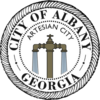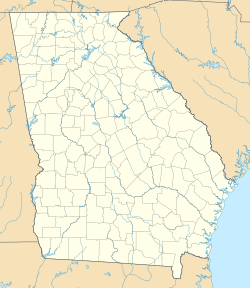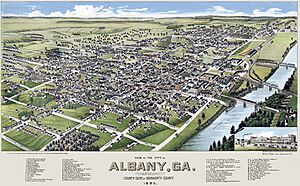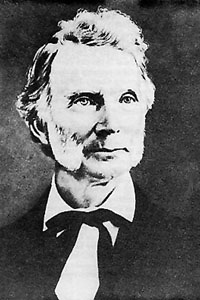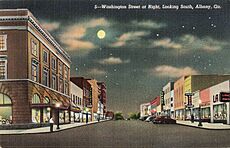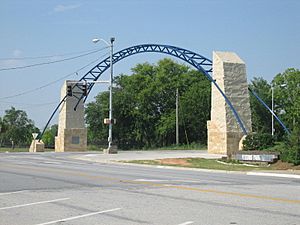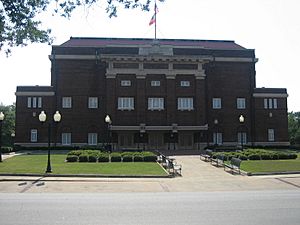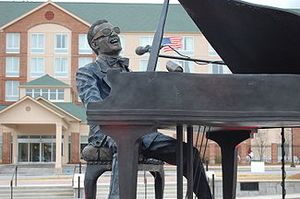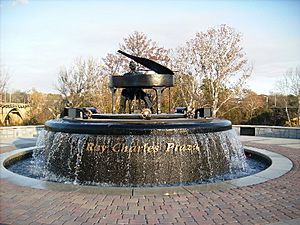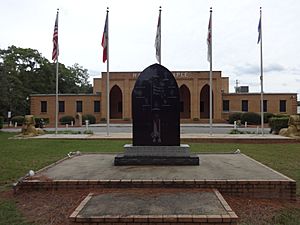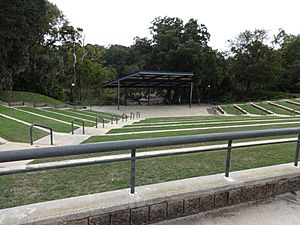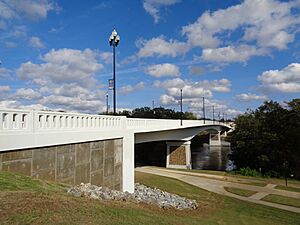Albany, Georgia facts for kids
Quick facts for kids
Albany
|
|||||
|---|---|---|---|---|---|
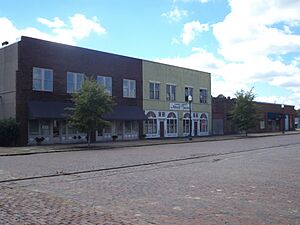
Albany Railroad Historic District
|
|||||
|
|||||
| Nicknames:
The Good Life City, The Artesian City, Egypt of America
|
|||||
| Motto(s):
"There's only one Albany, Georgia"
|
|||||
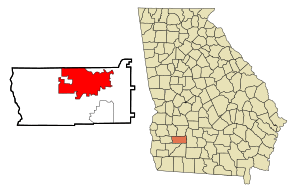
Location in Dougherty County and Georgia
|
|||||
| Country | United States | ||||
| State | Georgia | ||||
| County | Dougherty | ||||
| Incorporated (city) | December 27, 1838 | ||||
| Area | |||||
| • City | 55.83 sq mi (144.59 km2) | ||||
| • Land | 55.06 sq mi (142.62 km2) | ||||
| • Water | 0.76 sq mi (1.98 km2) | ||||
| Elevation | 203 ft (62 m) | ||||
| Population
(2020)
|
|||||
| • City | 68,089 | ||||
| • Density | 1,264.84/sq mi (488.35/km2) | ||||
| • Urban | 76,434 | ||||
| • Metro | 146,961 (US:289 List of Metropolitan Statistical Areas) | ||||
| Demonym(s) | Albanian | ||||
| Time zone | UTC−5 (EST) | ||||
| • Summer (DST) | UTC−4 (EDT) | ||||
| ZIP code(s) |
31701, 31705, 31707, 31721, 31763
|
||||
| Area code(s) | 229 | ||||
| FIPS code | 13-01052 | ||||
| GNIS feature ID | 0310424 | ||||
Albany (pronounced awl-BIH-nee) is a city in the state of Georgia, USA. It is located on the Flint River and is the main city in Dougherty County. Albany is also the biggest city in the Albany metropolitan area. In 2020, about 68,089 people lived here.
In the 1800s, Albany became an important place for shipping and trade. First, riverboats connected it to the busy port of Apalachicola, Florida. Later, railroads took over. Seven different train lines met in Albany, making it a major trade center in the Southeast.
Albany is in a special area called the Black Belt, which has rich soil perfect for growing cotton. In the mid-1900s, the city received money for military bases, which helped the area grow. Albany was also a key location during the Civil Rights Movement in the early 1960s. Today, even with changes in railroads and military bases, the city continues to develop new businesses.
Contents
History of Albany
Albany is in a region that was once home to the Creek Indians. They called the area Thronateeska, which means "flint," after the valuable stone found near the Flint River. The Creek people used flint to make tools. In 1830, the U.S. Congress passed the Indian Removal Act. This led to treaties that removed the Creek and other Native American groups from their lands in the Southeast. The U.S. Army then moved most of these native peoples to lands west of the Mississippi River.
Founding of Albany
European-American settlers began to arrive after the Native Americans were moved. Nelson Tift from Groton, Connecticut, claimed land along the Flint River in October 1836. Tift and his partners named the new town Albany, after New York's capital. They hoped their new town, located near the start of the Flint River, would become as successful as New York's Albany, which was a big trade center on the Hudson River.
The town was designed by Alexander Shotwell in 1836. It officially became a city on December 27, 1838. Nelson Tift was a very important person in Albany for many years. He supported education, businesses, and building railroads.
This area became known for growing cotton. Plantation owners used many enslaved African Americans to clear land and work the cotton fields. By 1840, most people in Dougherty County were enslaved African Americans. Albany was a perfect spot for shipping cotton to other markets using steamboats. In 1858, Tift hired Horace King, a skilled bridge builder, to build a toll bridge over the river. King's old toll house is still standing today.
Albany was already a key shipping port. Later, it became a major railroad center in southwest Georgia, with seven train lines coming into town. You can learn about trains at the Thronateeska Heritage Center, which is in the old railroad station.
Newspapers and Growth
After the Civil War, Carey Wentworth Styles moved to Albany and started a newspaper called the Albany News. He later moved to Atlanta and helped start The Constitution newspaper. Styles eventually returned to Albany and continued to work on the News.
Albany in the 20th Century
The Flint River has always been important to Albany, but it has also caused floods. Major floods happened in 1841 and 1925. The city has also faced tornadoes. On February 10, 1940, a strong tornado hit Albany, causing a lot of damage and taking lives.
1940 Tornado Gallery
In 1906, the Carnegie Library opened downtown. It was built with help from the generous person Andrew Carnegie. At first, due to Jim Crow laws, the library was only for white people. African Americans could not use it until after the Civil Rights Act of 1964 was passed. The building is now the home of the Albany Area Arts Council.
In 1937, Chehaw Park was built as part of a New Deal program during the Great Depression. This program helped create jobs during a tough economic time.
Big changes came to Albany with the building of military bases. A U.S. Army Air Corps training base was built near the city in 1941. After World War II, it became Turner Air Force Base for the U.S. Air Force. They used it for large bomber jets like the B-52 Stratofortress.
In 1951, the U.S. Marine Corps built a logistics base on the edge of Albany. Many military families moved to the city, and for a short time, more white people lived in Albany than Black people.
By 1960, Albany's population reached 50,000. In 1961–1962, African Americans in Albany played a big part in the Civil Rights Movement. They organized peaceful protests to end segregation in public places and to gain the right to vote. With help from groups like the SCLC and the NAACP, they worked for social justice. The city ended its Jim Crow laws in 1963. However, African Americans could not fully use their voting rights until the Voting Rights Act of 1965 was passed.
In 1967, the Air Force closed its base, and it was given to the U.S. Navy, becoming Naval Air Station Albany. Later, in 1974, the base closed completely and the land was returned to the city. In 1979, the Miller Brewing Company bought part of the old base to build a new brewery.
Over time, fewer military bases and changes in the railroad industry led to job losses in Albany. Many white residents moved to the suburbs, and by the 1970s, Albany became a city with a majority African American population again.
The Flint River has flooded severely several times. In 1994, Tropical Storm Alberto caused a huge flood, forcing 22,000 people to leave their homes. In 1998, the river flooded parts of the city again. Because of these floods, the city has decided not to build homes or businesses right along the river. Instead, they are making the riverfront a nice area with a walkway and a new aquarium.
In 2017, strong tornadoes hit the area, and in 2018, Hurricane Michael caused widespread damage.
Geography of Albany
Albany is located in Southwest Georgia, at coordinates 31.582273, −84.165557. It sits on the banks of the Flint River, in an area known for its rich farmland. The city is about 78 miles (126 km) southeast of Columbus and 151 miles (243 km) south of Atlanta.
Albany is known for its many trees. For 23 years, it has been part of the Arbor Day Foundation's Tree City USA Program. The city has rules to protect its trees and even has an expert arborist on staff.
Albany's Climate
Albany has a humid subtropical climate, which means it has hot, humid summers and generally mild to cool winters. The city gets a lot of rain, often in heavy showers and thunderstorms. Albany experiences thunder on about 86 days each year, which is more than twice the national average.
| Climate data for Albany, Georgia (1991–2020 normals, extremes 1891–present) | |||||||||||||
|---|---|---|---|---|---|---|---|---|---|---|---|---|---|
| Month | Jan | Feb | Mar | Apr | May | Jun | Jul | Aug | Sep | Oct | Nov | Dec | Year |
| Record high °F (°C) | 83 (28) |
86 (30) |
93 (34) |
97 (36) |
102 (39) |
106 (41) |
107 (42) |
104 (40) |
106 (41) |
99 (37) |
90 (32) |
88 (31) |
107 (42) |
| Mean daily maximum °F (°C) | 59.5 (15.3) |
63.8 (17.7) |
70.8 (21.6) |
77.6 (25.3) |
84.8 (29.3) |
89.3 (31.8) |
91.6 (33.1) |
90.6 (32.6) |
86.8 (30.4) |
78.7 (25.9) |
69.3 (20.7) |
62.3 (16.8) |
77.1 (25.1) |
| Daily mean °F (°C) | 48.4 (9.1) |
52.2 (11.2) |
58.5 (14.7) |
65.2 (18.4) |
73.1 (22.8) |
79.3 (26.3) |
81.9 (27.7) |
81.1 (27.3) |
76.9 (24.9) |
67.4 (19.7) |
57.1 (13.9) |
51.2 (10.7) |
66.0 (18.9) |
| Mean daily minimum °F (°C) | 37.3 (2.9) |
40.5 (4.7) |
46.2 (7.9) |
52.8 (11.6) |
61.5 (16.4) |
69.3 (20.7) |
72.2 (22.3) |
71.7 (22.1) |
67.0 (19.4) |
56.1 (13.4) |
44.9 (7.2) |
40.1 (4.5) |
55.0 (12.8) |
| Record low °F (°C) | 1 (−17) |
11 (−12) |
10 (−12) |
27 (−3) |
39 (4) |
46 (8) |
57 (14) |
56 (13) |
37 (3) |
28 (−2) |
14 (−10) |
6 (−14) |
1 (−17) |
| Average precipitation inches (mm) | 4.78 (121) |
4.72 (120) |
4.88 (124) |
3.92 (100) |
3.03 (77) |
5.24 (133) |
5.50 (140) |
5.69 (145) |
4.03 (102) |
3.04 (77) |
3.04 (77) |
4.68 (119) |
52.55 (1,335) |
| Average precipitation days (≥ 0.01 in) | 9.6 | 9.0 | 8.4 | 7.0 | 6.2 | 11.7 | 11.8 | 12.2 | 7.6 | 6.1 | 6.6 | 9.1 | 105.3 |
| Source: NOAA | |||||||||||||
People of Albany
| Historical population | |||
|---|---|---|---|
| Census | Pop. | %± | |
| 1860 | 1,618 | — | |
| 1870 | 2,101 | 29.9% | |
| 1880 | 3,216 | 53.1% | |
| 1890 | 4,008 | 24.6% | |
| 1900 | 4,606 | 14.9% | |
| 1910 | 8,190 | 77.8% | |
| 1920 | 11,555 | 41.1% | |
| 1930 | 14,507 | 25.5% | |
| 1940 | 19,055 | 31.4% | |
| 1950 | 31,155 | 63.5% | |
| 1960 | 55,890 | 79.4% | |
| 1970 | 72,623 | 29.9% | |
| 1980 | 74,425 | 2.5% | |
| 1990 | 78,122 | 5.0% | |
| 2000 | 76,939 | −1.5% | |
| 2010 | 77,434 | 0.6% | |
| 2020 | 69,647 | −10.1% | |
| U.S. Decennial Census 1850-1870 1870-1880 1890-1910 1920-1930 1940 1950 1960 1970 1980 1990 2000 2010 |
|||
| Race | Num. | Perc. |
|---|---|---|
| White (non-Hispanic) | 13,724 | 19.71% |
| Black or African American (non-Hispanic) | 51,952 | 74.59% |
| Native American | 89 | 0.13% |
| Asian | 508 | 0.73% |
| Pacific Islander | 13 | 0.02% |
| Other/Mixed | 1,717 | 2.47% |
| Hispanic or Latino | 1,644 | 2.36% |
In 1860, Albany had 1,618 people. Its population grew to a high of 78,122 before dropping to 69,647 in 2020.
Albany is part of the Black Belt region. In 2020, about 74.59% of the people were Black or African American, and 19.71% were white. Other groups included Asian, Native American, and people of mixed races. About 2.36% of the population was Hispanic or Latino.
In 2022, the average age in Albany was 34.7 years old. The city had a median household income of $39,422. About 33.8% of the people lived at or below the poverty line.
Albany's Economy
Today, Albany is surrounded by pecan groves, pine trees, and farms. However, most people in the city do not work in agriculture. Albany has become a city with many industries and businesses that operate on a large scale.
The biggest employers in Albany are health care, education, and the Marine Corps Logistics Base Albany. Manufacturing, transportation, and retail trade are also important parts of Albany's economy. The city serves as a central point for business in southwest Georgia.
In 2008, Cooper Tire and Rubber, a large employer, announced plans to close its local factory. This meant about 1,400 people lost their jobs. Despite this, Albany has worked to add new jobs and improve its economy.
Albany has a skilled workforce and continues to improve its public services. The city also has programs to help new businesses start and grow.
Arts and Culture in Albany
Museums and Arts Centers
- Albany Area Arts Council
- The Albany Chorale
- Albany Civic Center
- Albany Civil Rights Institute
- The Albany Concert Association
- Albany Municipal Auditorium
- Albany Museum of Art
- The Albany Symphony Orchestra
- Ballet Theatre South
- Flint RiverQuarium
- The Parks at Chehaw has one of two accredited zoos in the state.
- RiverQuarium Imagination Theater
- Theatre Albany
- Thronateeska Heritage Center
- Weatherbee Planetarium
Historic Places to Visit
- Albany District Pecan Growers' Exchange
- Albany Housefurnishing Company
- Albany Municipal Auditorium
- Albany Railroad Depot Historic District
- Bridge House
- Carnegie Library of Albany
- Davis-Exchange Bank Building
- John A. Davis House
- Mount Zion Baptist Church
- New Albany Hotel
- Old St. Teresa's Catholic Church
- Rosenberg Brothers Department Store
- St. Nicholas Hotel
- Samuel Farkas House
- Tift Park
- U.S. Post Office and Courthouse
- Union Station Depot
- W. E. Smith House
Sports in Albany
- Albany was home to the Albany Polecats, a minor league baseball team from 1992 to 1995.
- The Albany Panthers were an indoor football team that played at the James H. Gray Civic Center until 2014.
- The Georgia Firebirds were another indoor football team that played in Albany.
- Albany is home to Sowegans SC, an amateur soccer team that started in 2023. They play their home games at Westover Comprehensive High School.
- [Craft Axe Throwing Albany] opened in 2019, bringing the sport of axe throwing to the city.
Memorials and Sights
- Albany Civil Rights Memorial
- Albany Railroad Depot Historic District
- Astronauts Memorial
- Confederate Memorial Park
- The Flint Riverquarium
- Freedom Flame
- Freedom Walk
- The Guardian
- Radium Springs – one of the Seven Natural Wonders of Georgia
- Ray Charles Plaza
- RiverFront Park
- Royal Air Force Memorial
- Veterans Park
Festivals and Events
Albany hosts city races, including a 26.2-mile (42.2 km) full marathon and a 13.1-mile (21.1 km) half marathon. The full marathon is known as one of the best races for qualifying for the Boston Marathon.
The annual Mardi Gras Street Festival happens in downtown Albany on the first weekend of March. It starts at noon and goes until midnight, happening at the same time as the marathon and half marathon.
Education in Albany
Public Schools
The Dougherty County School System runs five learning centers, fourteen elementary schools, four middle schools, three high schools, and one alternative school. All schools are approved by important education groups. In 2009–2010, the system had 15,838 students and 1,070 teachers.
Some schools have special awards:
- Alice Coachman Elementary School: 2009 National Blue Ribbon School
- Lincoln Elementary Magnet School: Received an award for student achievement in 2009–2010.
- International Studies Elementary Charter School: Recognized for making good progress for 10 years in a row.
- Robert A. Cross Middle Magnet School: Received an award for student achievement in 2009–2010.
Private Schools
Several private schools offer education for younger students:
- Byne Memorial Baptist School (BMBS)
- Deerfield-Windsor School (DWS)
- God's Foundation Christian Academy (GFCA)
- St. Teresa's Catholic School (STS)
- Sherwood Christian Academy (SCA)
- Christian Covenant Academy (CCA)
Colleges and Universities
Albany State University
Albany State University is located in the city. It was started in 1903. This university is special because it is one of the few historically black colleges and universities that are part of the University System of Georgia.
Albany Technical College
Albany Technical College is part of the Technical College System of Georgia. It teaches job skills and training for different careers.
Georgia Military College (GMC) also has a location on this campus, offering some classes.
Troy University
Troy University, a public university from Alabama, has a location in Albany. For over 20 years, Troy University has offered classes in Albany, both in person and online. They have programs in areas like criminal justice and psychology.
Public Libraries
The Dougherty County Public Library manages the public libraries in Albany.
Media in Albany
Newspapers
- The Albany Herald, started in 1891.
- The Albany Journal, published since 1939.
- The Albany Southwest Georgian, a newspaper for the Black community.
- The Metro Gazette, started in 2010, shares positive community news.
Television Stations
FM Radio Stations
- 88.5 W203AT (religious)
- 89.3 WBJY (religious)
- 90.3 WAEF (religious)
- 90.7 WWQA (religious, bluegrass)
- 91.7 WUNV (NPR – news, classical)
- 92.7 WASU (Albany State University – college, jazz, urban)
- 93.1 WSRD (religious, talk)
- 93.5 WMRG (hip-hop/R&B)
- 93.9 WMTM (Classic hits)
- 94.7 WDEC (hot adult contemporary)
- 96.3 WJIZ (urban)
- 97.3 WGEX "Power 97.3" (Top 40)
- 98.1 WMRZ "Kiss" (adult urban)
- 100.3 WOBB "B-100"(country)
- 101.3 WTOA-LP Catholic radio
- 101.7 WQVE "V101.7"(R&B, classic soul)
- 102.1 WJST "Retro FM 102.1" (classic hits)
- 102.5 W273AE (religious)
- 103.5 WJAD "Rock 103" (classic and mainstream rock) (Leesburg)
- 104.5 WKAK "Nash FM" (country)
- 105.5 WZBN "Power 105... The King" (holy hip hop and contemporary gospel)
- 106.1 WHKV (Christian contemporary)
- 106.5 WZIQ (Christian)
- 107.7 WNOU "107.7 Now-FM" (Hot adult contemporary)
AM Radio Stations
- 960 WJYZ (gospel)
- 1250 WSRA (ESPN sports)
- 1590 WALG (news, talk)
Albany's Infrastructure
Transportation
Air Travel
Southwest Georgia Regional Airport (ABY) is a commercial airport with flights to Atlanta through Endeavor Air, a regional airline for Delta. Both UPS and DHL use the airport for sorting packages.
Rail Transport
Freight train services are provided by Georgia Southwestern Railroad, Georgia and Florida Railway/Omnitrax, and Norfolk Southern Railway. The Georgia and Florida Railway has its main office in Albany.
In the past, passenger trains from cities like St. Louis and Chicago would stop at Albany Union Station on their way to Florida. The last of these trains stopped in 1971.
Bus Services
The Albany Transit System (ATS) has been operated by the city since 1974. It provides bus services around Albany and Dougherty County, including to the airport. All buses are wheelchair accessible and have bike racks. The main bus station is downtown.
There is also a Greyhound bus station in downtown Albany for longer trips to other cities.
Roads and Bridges
While Albany does not have an interstate highway directly through it, U.S. Route 19 and U.S. Route 82 are major roads that pass through the city. These two roads join north of the city to form a short highway called the Liberty Expressway. Other important highways include Georgia State Route 91, Georgia State Route 133, Georgia State Route 234, and Georgia State Route 520. Albany is also on Georgia State Route 300, which connects to Interstate 75.
Bridges
Albany's Broad Avenue Memorial Bridge, built in 1920, was closed in 2009 because it was unsafe. A new bridge was built and opened on November 11, 2015, dedicated to veterans.
Energy and Water
Parts of Albany get electricity from Georgia Power, which has two power plants in Dougherty County.
The Albany Water, Gas & Light Commission (WG&L) provides water, gas, and electricity to the city. Albany gets its drinking water from underground sources called aquifers. The water quality is very good and only needs basic treatment.
Communications
Both WG&L and AT&T provide communication services in Albany.
Waste Management
Albany's trash is taken to the Dougherty County Landfill, located southeast of the city.
Notable People from Albany
- Ray Charles: Famous singer, songwriter, and pianist.
- Alice Coachman: The first Black woman to win an Olympic gold medal.
- Mary Francis Hill Coley: A midwife who worked in Albany for many years.
- Paula Deen: A TV personality and cooking show host.
- Field Mob: A hip hop music group.
- Bart Oates: A football player who won three Super Bowls.
- McCree Harris: An activist during the Albany Movement.
- Reginald D. Hunter: A stand-up comedian.
- Harry James: A famous trumpet player and bandleader from the Swing era.
- Alex Kendrick: An actor, director, and filmmaker.
- Stephen Kendrick: An actor, director, and filmmaker.
- Ray Knight: A former Major League Baseball player.
- Phillip Phillips: A singer-songwriter who won American Idol.
- Bobby Rush: A pastor and U.S. Representative.
- Kylie Sonique Love: A drag queen who won RuPaul's Drag Race All Stars.
- Harry Spilman: A former Major League Baseball player.
- Angelo Taylor: An Olympic gold medalist in athletics.
- Jo Marie Payton: An actress.
- Geraldine W. Travis: The first Black woman to serve in the Montana House of Representatives.
- James Wheeler: A blues guitarist, singer, and songwriter.
- Daryl Smith: A former National Football League linebacker.
- Bernice Johnson Reagon: A song leader, historian, musician, and social activist.
Images for kids
See also
 In Spanish: Albany (Georgia) para niños
In Spanish: Albany (Georgia) para niños


